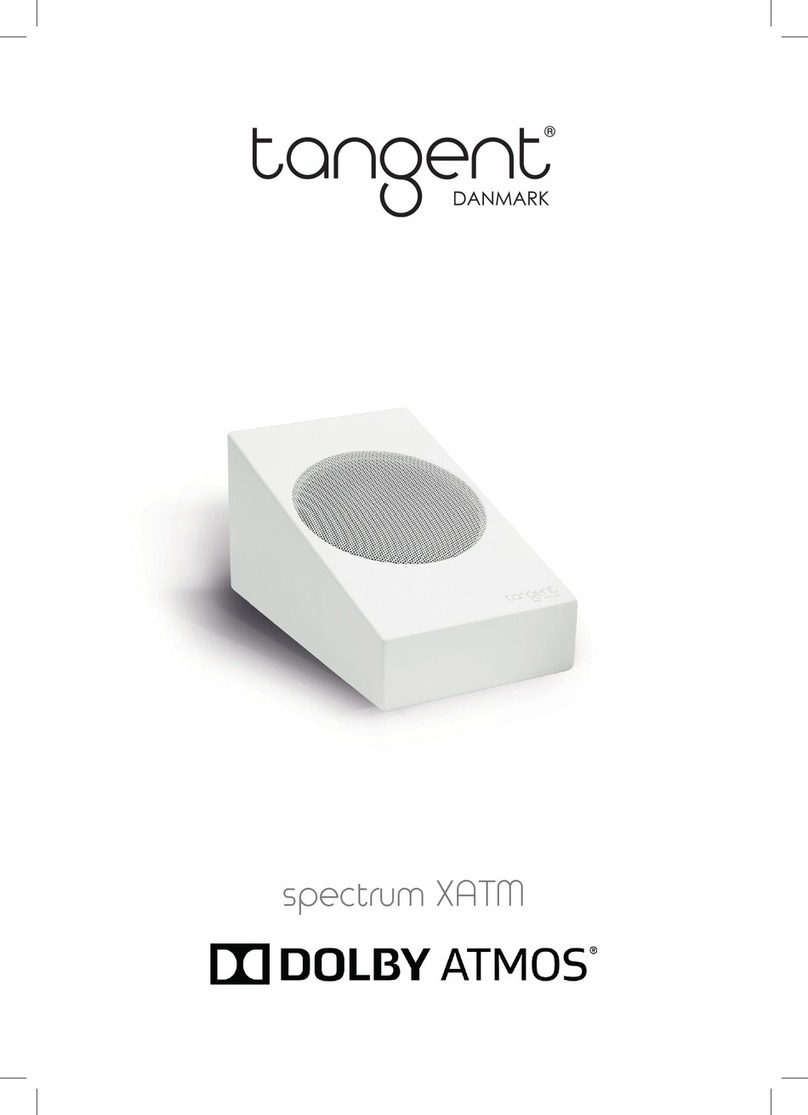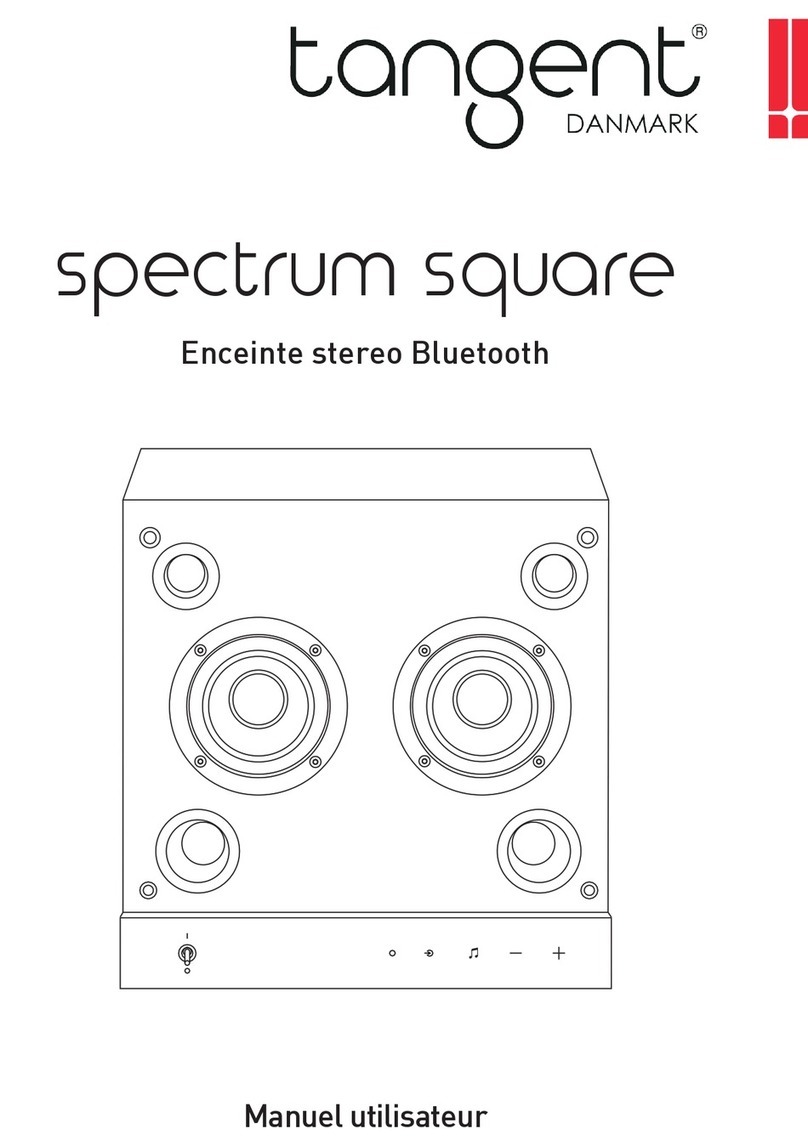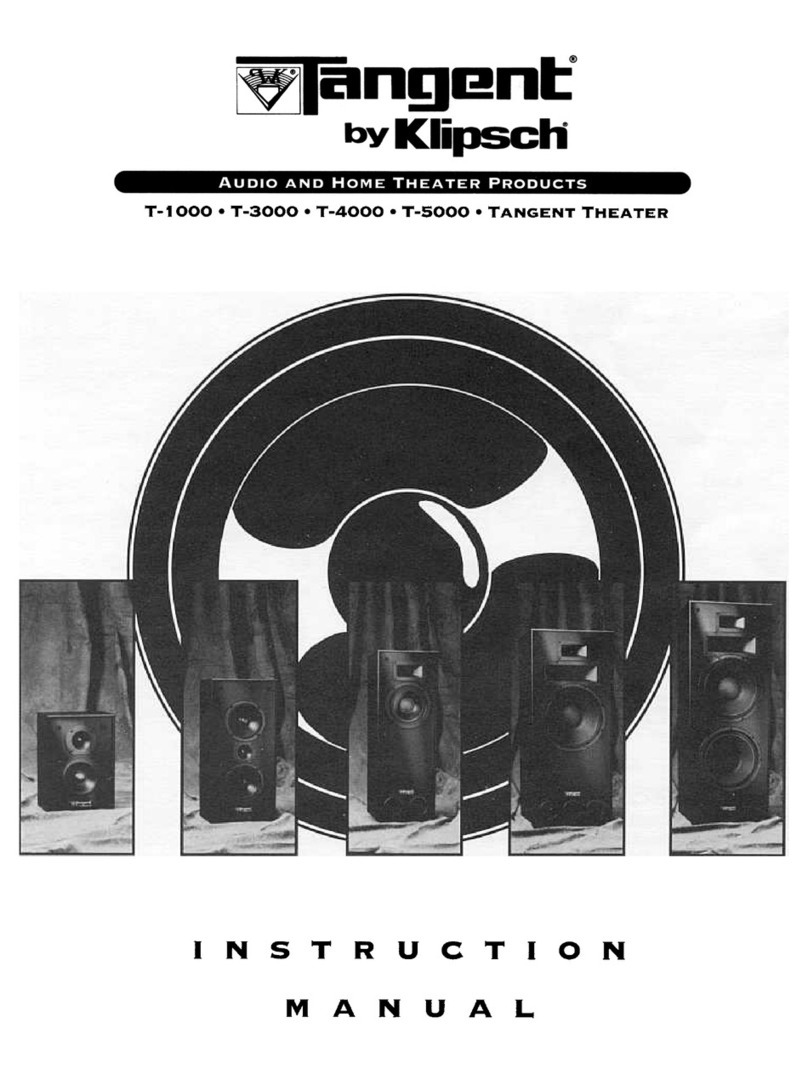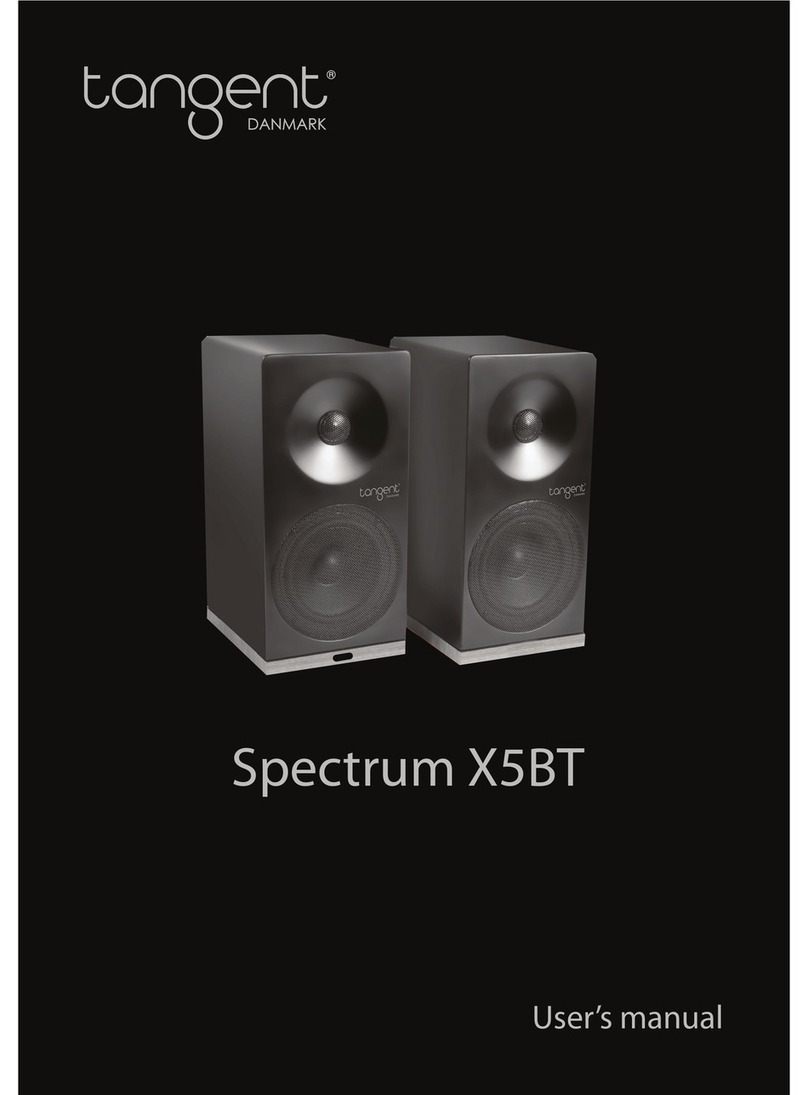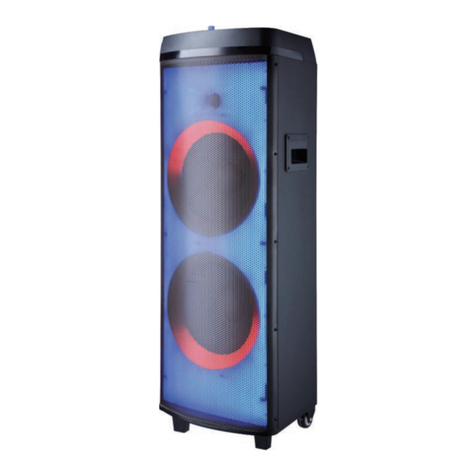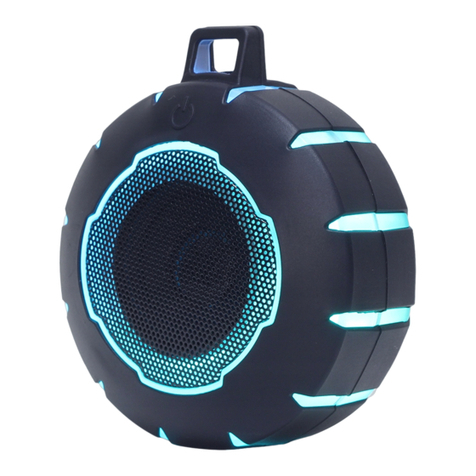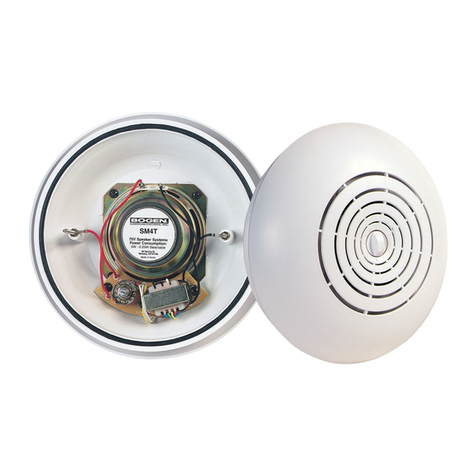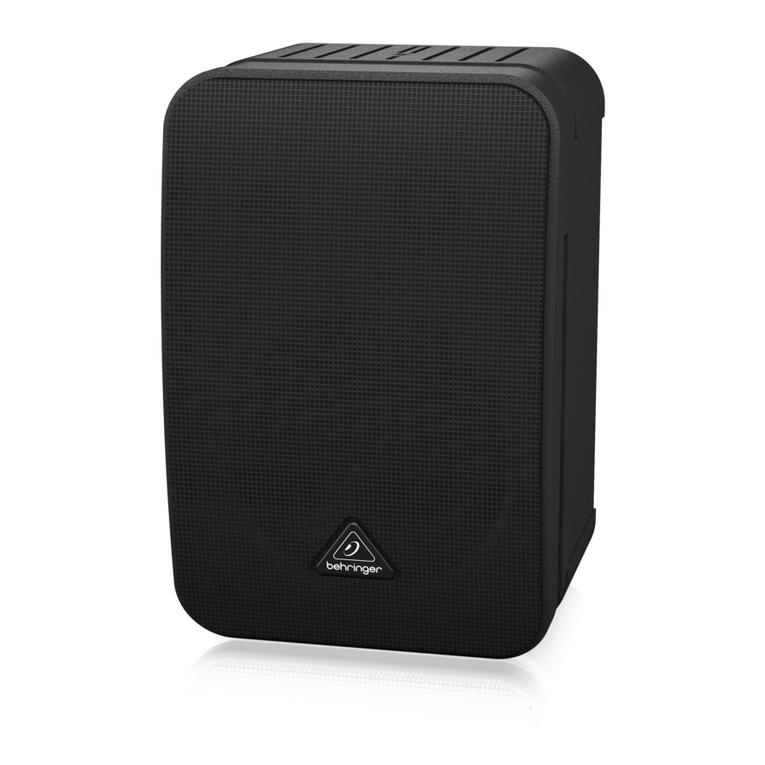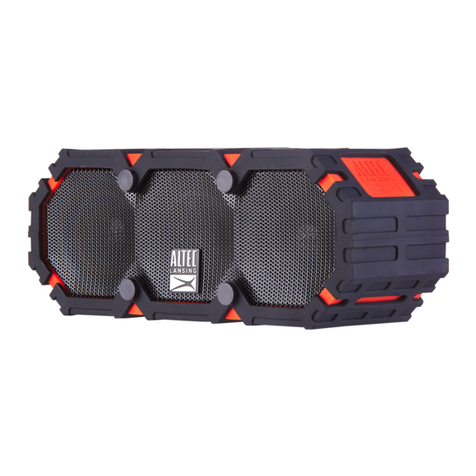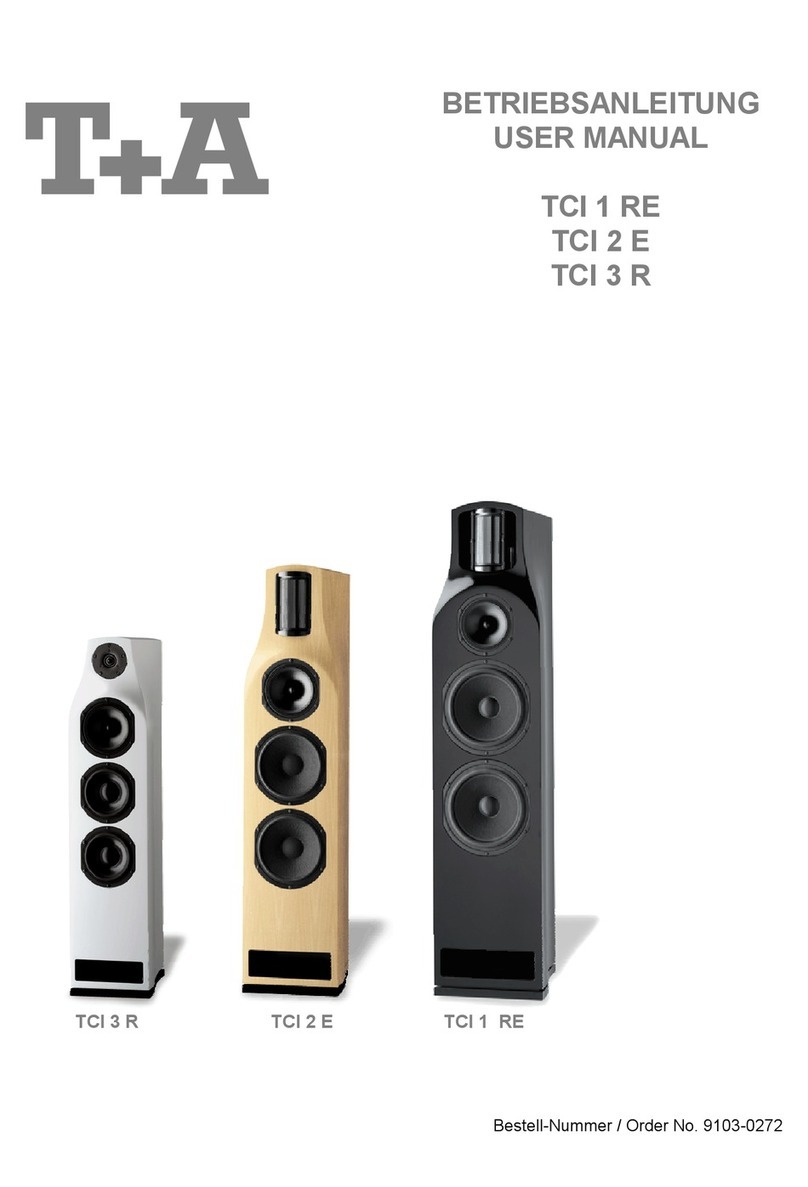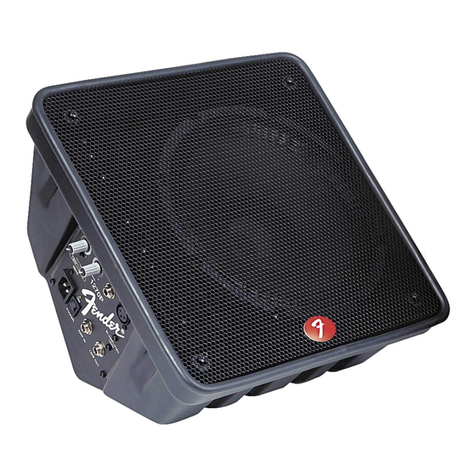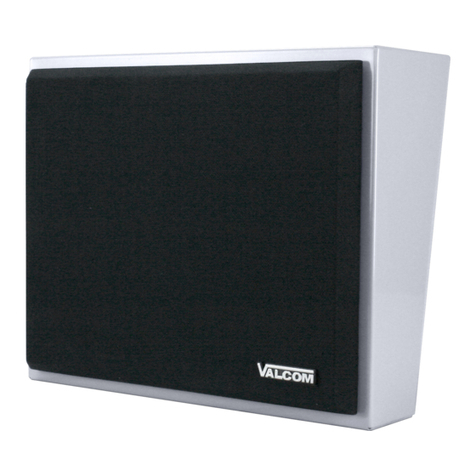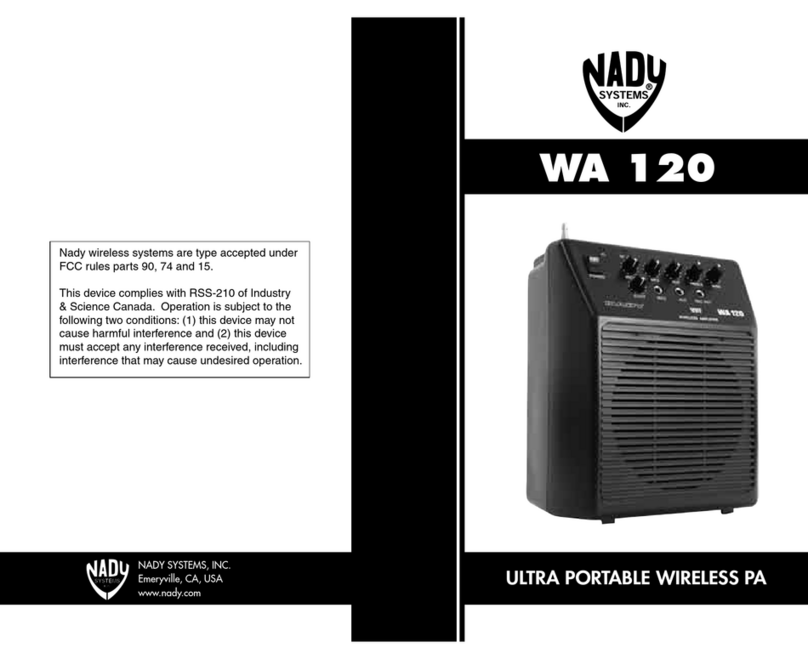Tangent EVO E5A User manual

1
Multi language instructions manual

2

3
UK - USER MANUAL 5
FR - MANUEL DE L’UTILISATEUR 15
D – BEDIENUNGSANLEITUNG 26
NL - GEBRUIKSAANWIJZING 37
DK - BETJENINGSVEJLEDNING 49
SE - ANVÄNDARMANUAL 60
FI - KÄYTTÖOHJEKIRJA 71
I – MANUALE D’USO 82
ES - MANUAL DEL USUARIO 93
P – MANUAL DE INSTRUÇÕES 104

4

5
UK - USER MANUAL
Safety precautions
A triangle with a lightning symbol draws the user's attention to "dangerous voltage" without
insulation in the cabinet, which may be high enough to entail a risk of electric shock.
A triangle with an exclamation mark draws the user's attention to important instructions for
use and maintenance in the enclosed manual, which should be studied.
A symbol for CLASS II (double insulation)
WARNING:
TO MINIMISE THE RISK OF FIRE OR ELECTRICAL SHOCK, DO NOT EXPOSE THE
UNIT TO RAIN OR MOISTURE. DO NOT OPEN THE CABINET AS IT CONTAINS
DANGEROUS VOLTAGE. ONLY QUALIFIED TECHNICIANS ARE ALLOWED TO CARRY
OUT REPAIR AND SERVICE.
CAUTION:
If the plug of the power cord needs to be replaced, it is important that the replacement is
identical to the plug to be replaced, or that the new plug has been recommended by the
manufacturer
TO AVOID ELECTRICAL SHOCK, IT IS IMPORTANT TO INSERT THE PLUG
CORRECTLY INTO THE SOCKET.

6
Important safety instructions
WARNING: IT IS IMPORTANT THAT YOU READ AND OBSERVE BOTH THE
INSTRUCTIONS IN THIS MANUAL AND THE INSTRUCTIONS ON THE UNIT. KEEP THIS
MANUAL FOR FUTURE REFERENCE. This unit was designed and manufactured with a
view to providing maximum safety for the user. Incorrect use of the unit may cause electrical
shock or fire. The protection devices built into this unit will protect the user if the procedures
below are observed in connection with installation, use and repair. This unit is fully
electronic and contains no parts that can be repaired by the user. DO NOT REMOVE THE
CABINET. RISK OF DANGEROUS VOLTAGE. ONLY QUALIFIED TECHNICIANS ARE
ALLOWED TO REPAIR THE UNIT.
Read the manual: Upon unpacking the unit, please read the manual carefully and observe
all the instructions given.
Power supply: Only the power supply indicated on the rating plate must be used for this
unit. If you are not sure which power supply you have, please contact the distributor or the
local electricity supplier.
Earthing or polarization: If the plug cannot be inserted properly into the socket, or if the
plug does not fit, the unit must not be used in your country.
Ventilation: The cabinet is provided with slots and openings to ensure ventilation and
reliable operation and to protect the unit against overheating. Do not block or cover these
openings. The openings must never be blocked, for instance by placing the unit on a bed, a
sofa, a carpet or similar surface.
Heat: Do not place the unit near sources of heat such as radiators, heat registers, ovens or
other units that produce heat.
Water and moisture: The unit must not be placed close to water, such as bathtub,
washbasin, kitchen sink or laundry tub, in a damp cellar or close to a swimming pool, etc.
Cleaning: Unplug the unit before cleaning. Do not use liquid detergents and aerosol
cleaning agents. Use a dry cloth.
Power cords: Wiring must be organized to prevent people from stepping on the cables and
to avoid pinching by objects placed on or beside them. Take special care around sockets
and plug boxes and where the power cords leave the unit.
Overloading: Make sure that wall sockets, extension cords and plug boxes are not
overloaded as this may lead to fire or electrical shock.

7
Important safety instructions
Lightning
Unplug the unit for additional protection during thunder or when the unit is not used for
prolonged periods. This will prevent damage to the unit from lightning and power surges.
Penetration of objects and liquid
Never push any foreign objects through the openings into the unit, as they may touch
dangerous voltage points or short-circuit parts and thus cause fire or electric shock. Do not
spill liquid on the unit.
Accessories
Do not place the unit on unstable surfaces such as a trolley, stand, tripod, shelf or table.
The unit may fall and injure children or adults or be seriously damaged. Use only trolley,
stand, tripod, shelf or table that is very stable or provided with the unit. The unit must be
installed in accordance with the manufacturer's instructions and by means of installation
equipment recommended by the manufacturer. If the unit is placed on a trolley, the trolley
must be moved very carefully. Sudden stops, unnecessary force and uneven surfaces may
cause the trolley to turn over.
Loads
Do not place heavy loads on the unit and do not step on it. The load may fall and cause
serious injury to persons or damage to the unit.
Damage
Unplug the unit and contact qualified technicians in the following cases:
A) If the power cord or the plug is damaged.
B) If liquid has been spilled on the unit or objects have fallen into the unit.
C) If the unit has been exposed to rain or water.
D) If the unit does not work properly after adhering to the instructions in the operation
manual. Only the settings described in the operation manual must be made as
incorrect setting may result in damage and often will make it difficult for a qualified
technician to make the unit work properly again.
E) If the unit has been dropped or damaged in any other way.
F) When the operation of the unit changes drastically, the unit requires service.
Service
Do not attempt to carry out any service work yourself. By opening or removing the cabinet,
you will be exposed to dangerous voltage or other hazards. Any service work should be
carried out by qualified technicians.
Spare parts
If spare parts are required, make sure that the service technician uses spare parts specified
by the manufacturer or spare parts with the same characteristics as the original.
Unauthorized spare parts may cause fire, electrical shock, etc.
Safety check
After service or repairs on the unit, ask the service technician to carry out a safety check to
ensure that the unit is ready for use.

8
Important information
Handling instructions
- The top and back panel of the unit may become warm after prolonged use. This is not
due to a defect.
- Turn off the power when the unit is not used.
Protect the power cord
- Follow the instructions below to prevent abnormal operation, electrical shock, fire or
personal injury:
- Hold the plug firmly when inserting it into the socket.
- Avoid heat-producing devices.
- Do not place objects on the power cord.
- Do not carry out service work on or change the power cord.
Positioning
Do not place the unit in any of the fol. places:
- In sunlight, close to heat-producing devices or in an enclosed rack.
- In places with high temperatures (40C or more) or high relative humidity (90% or
more).
- In dirty places as some internal parts may be damaged.
Do not put your fingers or any other objects into the unit
- Touching the internal parts is dangerous and may cause injury or damage. Do not
open the cabinet.
- Do not place any foreign matter in the unit.
Interference
Placing the unit near a television set, radio or video player may cause poor picture and
sound quality. In that case, move the unit further away from the television set, radio or video
player.
Condensation
Condensation may occur in the following cases:
- When the unit is moved directly from a cold to a warm place.
- When the unit is used in a room where the radiator has just been switched on or a
place where the cold air from the air-conditioning system is directed at the unit.
- If the unit is used in the summer in a warm and humid room just after it has been
moved from an air-conditioned room.
- If there is steam or a high level of humidity in the room.
In case of condensation, the unit will not work properly. Turn off the unit. Unplug the unit
and leave it for 2-3 hours. The unit will then have adapted to the environment and any
condensation will have disappeared.

9
Loudspeaker positioning
Ideally the Tangent loudspeakers should be positioned at least 50 cm from a rear wall, 1
meter from a side wall and at least 2 metres apart. The space between the two
loudspeakers and the distance form the listeners are important. If loudspeakers are placed
too close together or too far apart, the stereo image will not be fully developed. In average
living rooms, speaker spacing between 2 and 4 metres will usually produce satisfactory
results. The listeners distance from the loudspeakers should be at least equal to and
preferably greater than the distance between the loudspeakers. Tests should be made with
both speech and music before deciding upon final locations.
The rear panel

10
The rear panel of this speaker is equipped with an amplifier for driving the speakers.
This makes the speaker extremely flexible for use in many different places.
1. Input
This 3.5mm stereo jack input can be connected to either a line output signal or a pre
output signal. The input can be both a stereo or a mono signal.
You can connect your MP3 player to this input via the head phone output on the MP3
player. please notice that if a signal is not provided for more than 10 minutes, the
speaker will go into standby by it self. Once a signal is provided again, the speaker will
turn on again.
Note: Do not attempt to connect a speaker output to this connecter. It will damage the
speaker.
2. Output
This 3.5mm stereo jack output is for connect another Tangent EVO E5A. It is also
possible to connect an active subwoofer to this output, if the bass level is not sufficient.
Please notice that the signal in this connecter will follow the signal in the input
connecter, when the “volume bypass” is set to ON.
3. Channel select
When a stereo signal is provided to the EVO E5A, it is possible to choose whether the
speaker should play as a LEFT speaker, a RIGHT speaker or a MONO speaker.
If two EVO E5A are connected to you setup, the speaker you have placed on the right
side, should be set to RIGHT, and the left speaker should be set to LEFT, in order to
obtain the correct stereo perspective.
If only one speaker is connected this switch should be set to “MONO”
4. Volume bypass
This switch has two settings:
ON: When the switch is set to ON, the volume level of the EVO E5A will be set to
maximum level and the speaker cannot be remote controlled anymore. This should be
used, when the source connected to the speakers are controlling the volume, or the
volume is controlled by the speaker this speaker is connected to.
OFF: When the switch is set to OFF, the volume and standby function can be
controlled by the remote. Please notice that the volume level on the OUTPUT
connecter is also controlled by the remote, when the volume bypass switch is set to
OFF.
5. On/Off
Mains power switch.
6. AC input
Check that all other connections have been made correctly before inserting the mains
plug into the wall socket. Then insert the plug into a suitable socket.
Note: If the unit is to be used abroad, you may need an adapter.
CAUTION: Do not turn on the power before all connections have been made correctly.
You might break your new unit. Check that all connections have been made correctly
before turning on the power. Check that the mains voltage is identical with the voltage
printed on the rear panel before turning on the power.

11
The remote
This speaker can be controlled via a remote control. The IR (Infrared) receiver is placed
between the tweeter and woofer. So the included remote control must be pointed towards
this area in order to control the speaker via the remote.
1. Standby
Press this button to set the speaker into standby. Press it again to turn on the speaker
again. If no signal is provided to the speaker for a period longer than 10 minutes, the
speaker will automatically go into standby.
Please notice that this button will not work, if the “volume bypass” button on the rear
panel is set to ON.
2. Volume decrease
Press this button to decrease the volume.
Please notice that this button will not work, if the “volume bypass” button on the rear
panel is set to ON.
3. Volume increase
Press this button to increase the volume.
Please notice that this button will not work, if the “volume bypass” button on the rear
panel is set to ON.

12
Connecting a stereo setup
The illustration below shows how to setup two speakers to a source. The stereo setup
shown below is with volume control via the first speaker in the chain.
The source is connected to the line input on the speaker to the left. This can be a MP3
player via the headphone output, it can be a CD player or it can be a source with a pre
output (Volume controlled.)
The line output from the left speaker is connected directly to the line input on the right
speaker. The output on the right speaker can be used for e.g. a subwoofer or another
Tangent EVO E5A.
The settings of the switches on the rear panels should be as described below.
The left speaker: The channel select switch must be set to L (left) since it the speaker that
is physically placed on the left side. If the physical position is switched, the channel select
switches on the speakers should be switches as well. That means the channel select switch
should always be the same as the physical placement of the speaker.
The volume bypass switch should be set to OFF. This way you can control the volume via
the included remote.

13
The right speaker: The channel select switch must be set to R (right) since it the speaker
that is physically placed on the right side. The channel select switch should always be the
same as the physical placement of the speaker.
The volume bypass switch should be set to ON. Then the volume will follow the signal
provided to the speaker, which in this case is controlled by the left speaker.
If no signal is provided to the speakers for a period longer than 10 minutes, both the
speakers will automatically go into standby.
Connecting a mono setup
The illustration below shows how to setup one speaker to a source. The mono setup shown
below is with volume control via the speaker.
The source is connected to the line input on the speaker. This can be a MP3 player via the
headphone output, it can be a CD player or it can be a source with a pre output (Volume
controlled.)
The settings of the switches on the rear panel should be as described below.
The channel select switch should be set to mono, since only one speaker is connected to
the setup. This way you are sure to get all the sounds from both the left and the right
channels of the input connected to the speaker.
The volume bypass should be set to OFF if you whish to be able to control the speaker via
remote. If you prefer to control the volume level via the source connected (it could be a MP3

14
player), the volume bypass switch should be set to ON. Then the speaker will turn on when
a source is connected. If no signal is provided to the speaker for a period longer than 10
minutes, the speaker will automatically go into standby.
Specifications
Amplifier
Input Sensitivity/impedance: 500mV/47Kohm
Line output level/impedance: up to 500mV/2.2Kohm
Rated Output Power(RMS): 20W (4ΩLoad Resistance, THD 0.7%)
Signal noise ratio: min. 90dB
Frequency Response: 40Hz~20KHz(+3/-1dB)
Power supply voltage: 220-240VAC~50/60Hz
Rear panel inputs: AC power input
3.5mm analog stereo jack input
Rear panel outputs: 3.5mm analog stereo jack output
Rear panel switches: Channel select switch
Volume bypass switch
Drivers
Woofer 5” fully shielded
Tweeter 25mm Neodynium soft dome
Cabinet
Weight 4,70kg
Dimensions (H x W x D) 230 x 145 x 200mm

15
FR - MANUEL DE L’UTILISATEUR
Précautions de sécurité
Un triangle avec une symbole d’éclair est destiné à attirer l’attention de l’utilisateur sur le
présence d’une ‘tension dangereuse’ non isolée dans l’enceinte de l’appareil et qui serait de
magnitude assez élevée pour constituer un danger d’électrocution.
Un triangle avec un point d’exclamation est destiné à attirer l’attention de l’utilisateur sur les
instructions importantes d’utilisation et de maintenance fournies dans ce manuel qui doit
être étudié.
Symbole de la CLASSE II (Isolation double)
AVERTISSEMENT :
AFIN DE RÉDUIRE LES RISQUES D’INCENDIE OU D’ÉLECTROCUTION, N’EXPOSEZ
PAS L’APPAREIL À LA PLUIE OU À L’HUMIDITÉ. NE PAS OUVRIR LE BOÎTIER CAR IL
CONTIENT UNE TENSION DANGEREUSE. SEULS DES TECHNICIENS QUALIFIÉS
SONT AUTORISÉS À EFFECTUER LES RÉPARATIONS ET L’ENTRETIEN DE
L’APPAREIL.
ATTENTION :
Si la prise du cordon d’alimentation a besoin d’être remplacée, il est important de la
remplacer par une prise identique ou par une prise recommandée par le fabricant.
AFIN D’ÉVITER LES RISQUES D’ÉLECTROCUTION, IL EST IMPORTANT D’INSÉRER LA
PRISE CORRECTEMENT DANS LA PRISE.

16
Instructions de sécurité importantes
AVERTISSEMENT : IL EST IMPORTANT DE LIRE ET D’OBSERVER À LA FOIS LES
INSTRUCTIONS REPORTÉES DANS CE MANUEL ET CELLES QUI SONT INSCRITES
SUR L’APPAREIL. VEUILLEZ CONSERVER CE MANUEL AFIN DE POUVOIR LE
CONSULTER ULTÉRIEUREMENT.
Cette appareil est conçu et fabriqué afin d’offrir un maximum de sécurité à l’utilisateur. Une
mauvaise utilisation de cet appareil peut entraîner une électrocution ou un incendie. Les
dispositifs de sécurité intégrés à cet appareil protégeront l’utilisateur si les procédures ci-
dessous concernant l’installation, l’utilisation et la réparation sont observées. Cet appareil
est entièrement électronique et ne contient pas de parties qui peuvent être réparées par
l’utilisateur lui-même.
NE RETIREZ PAS LE BOÎTIER. RISQUE DE TENSION DANGEREUSE. SEULS DES
TECHNICIENS QUALIFIÉS SONT AUTORISÉS À RÉPARER L’APPAREIL.
Veuillez lire le manuel:
Après avoir déballé l’appareil, veuillez lire soigneusement ce manuel et observer les
instructions données.
Alimentation:
Seule l’alimentation indiquée sur la plaque signalétique de l’appareil doit être utilisée pour
cet appareil. Si vous n’êtes pas sûr(e) de l’alimentation que vous avez, veuillez contacter
votre distributeur ou votre fournisseur local d’électricité.
Mise à masse ou polarization:
Si vous n’arrivez pas à insérer correctement la prise dans la prise murale ou s’il la prise ne
s’adapte pas, cela signifie que l’appareil ne peut pas être utilisé dans le pays dans lequel
vous vous trouvez.
Ventilation:
Le boîtier est équipé de rainures et d’ouvertures de ventilation afin d’assurer un
fonctionnement fiable et de protéger l’appareil des surchauffes. Ne pas bloquer ou couvrir
ces ouvertures. Les ouvertures ne doivent jamais être bloquées en plaçant par exemple
l'appareil sur un lit, un canapé, un tapis ou sur tout autre surface similaire.
Chaleur:
Ne pas installer l’appareil près de sources de chaleur comme les radiateurs, les
accumulateurs de chaleur, les fours ou d'autres appareils qui produisent de la chaleur.
Eau et humidité:
L’appareil ne doit pas être placé à proximité d’eau comme par exemple près d’une
baignoire, d’un lavabo, d’un évier ou d’une lessiveuse, dans un sous-sol humide ou à
proximité d’une piscine, etc.

17
Entretien:
Débranchez l’appareil avant de le nettoyer. Ne pas utiliser de détergents liquides et
d’agents nettoyants en aérosol. Veuillez utiliser un chiffon sec.
Cordons d’alimentation:
Le câblage doit être effectué de manière à empêcher qu’on ne trébuche sur un fil et afin
d’éviter que les câbles soient pincés par des objets placés sur ou à côté d’eux. Veuillez faire
plus particulièrement attention aux prises et aux réceptacles de prises et aux sorties de
cordons d’alimentation de l’appareil.
Surcharge:
Veuillez vous assurer que les prises murales, les rallonges et les réceptacles de prises ne
soient pas surchargés car cela pourrait causer un incendie ou une électrocution.
Instructions de sécurité importantes
Éclair
Débranchez l’appareil pour davantage de protection en cas de tonnerre ou lorsque
l’appareil ne sert pas pendant des périodes prolongées. Cela empêchera d'endommager
l'appareil en raison de la foudre et des surcharges de courant.
Insertion d'objets et de liquide
Ne pousser aucun objet dans les ouvertures de l'appareil car si des objets étaient insérés,
ils pourraient toucher des points de tension dangereux ou mettre en court-circuit les
parties ; ce qui entraînerait un incendie ou un choc électrique. Ne pas renverser de liquides
sur l’appareil.
Accessoires
Ne pas placer l’appareil sur des surfaces instables comme un chariot, un support, un
trépied une étagère ou une table. L’appareil pourrait tomber et blesser gravement des
enfants ou des adultes. N’utilisez un chariot, un support, un trépied, une étagère ou une
table que s’ils sont très stables ou fournis avec l’appareil. L’appareil doit être installé en
accord avec les instructions du fabricant et au moyen d’équipements d’installation
recommandés par le fabricant. Si vous placez l’appareil sur un chariot, ce dernier doit être
déplacé très soigneusement. Des arrêts brusques, une force inutile et des surfaces
irrégulières peuvent renverser le chariot.
Charges
Ne pas placer de charges lourdes sur l’appareil et ne pas marcher dessus. La charge
pourrait tomber et causer des blessures graves ou endommager gravement l’appareil.
Dommages
Débranchez l’appareil et veuillez contacter des techniciens qualifiés dans les cas suivants :

18
A) Lorsque le cordon d'alimentation ou la prise sont endommagés.
B) Si un liquide a été renversé ou que des objets sont tombés dans l'appareil.
C) Si l'appareil a été exposé à la pluie ou à l'eau.
D) Si l’appareil ne fonctionne pas correctement après avoir suivi les instructions
contenues dans le manuel d’utilisation. Vous ne devez procéder qu’aux réglages
décrits dans le manuel d’utilisation car un mauvais réglage pourrait endommager
l’appareil et souvent il est difficile pour un technicien qualifié de faire fonctionner
correctement l’appareil après un mauvais réglage.
E) Si l’appareil est tombé ou qu’il est endommagé de quelque manière que ce soit.
F) Lorsque le fonctionnement de l’appareil change radicalement, l’appareil a besoin d’être
entretenu.
Entretien
Ne tentez pas d’effectuer l’entretien vous-même. En ouvrant ou en retirant le boîtier, vous
serez exposé(e) à une tension dangereuse ou à d’autres risques. Tous les travaux
d’entretien doivent être effectués par des techniciens qualifiés.
Pièces détachées
Si vous avez besoin de pièces détachées, veuillez vous assurer que le technicien
d’entretien utilise des pièces détachées qui sont recommandées par le fabricant et qui ont
les mêmes caractéristiques que les pièces d’origine. Des pièces détachées qui ne sont pas
autorisées peuvent causer un incendie, une électrocution, etc.
Vérification de sécurité
Après entretien ou réparation de l’appareil, demandez au technicien d’entretien d’effectuer
une vérification de sécurité afin de vous assurer que l’appareil est prêt à l’emploi.
Informations importantes
Instructions de manipulation
- Les panneaux supérieur et arrière de l’appareil peuvent devenir très chauds après une
utilisation prolongée. Cela ne signifie pas que l’appareil est défectueux.
- Éteignez le courant lorsque vous n’utilisez pas l’appareil.
Protégez le cordon d'alimentation
- Suivez les instructions ci-dessous afin de prévenir un fonctionnement anormal, un choc
électrique, un incendie ou des blessures.
- Tenez la prise fermement lorsque vous l’insérez dans la prise murale.
- Veuillez éviter les appareils qui produisent de la chaleur.
- Ne placez pas d’objets sur le cordon d'alimentation.
- N’effectuez pas de travaux d’entretien et ne changez pas le cordon d’alimentation.

19
Emplacement
Ne placez pas l’appareil dans un des endroits suivants :
- À la lumière du soleil, à proximité d’appareils qui produisent de la chaleur ou sur une
étagère fermée.
- Dans des endroits à températures élevées (40°C ou plus) ou à humidité relative élevée
(90% ou plus).
- Dans des endroits sale car des parties intérieures pourraient être endommagées.
Ne placez pas vos doigts ou d’autres objets dans l’appareil
- Toucher les parties internes peut s’avérer dangereux et peut entraîner des blessures
ou des dommages. Ne pas ouvrir le boîtier.
- Ne pas placer d’objets étrangers dans l’appareil.
Interférences
En plaçant l’appareil près d’un poste de télévision, d’une radio ou d’un lecteur vidéo, vous
obtiendrez une mauvaise qualité d’image et de son. Dans ce cas, veuillez éloigner l’appareil
du poste de télévision, de la radio ou du lecteur vidéo.
Condensation
De la condensation peut se former dans les cas suivants :
- Lorsque l’appareil est déplacé directement d’une pièce froide à une pièce chaude.
- Lorsque l’appareil est utilisé dans une pièce où vous venez juste d’allumer le radiateur
ou dans laquelle l’air froid du système d’air conditionné est en direction de l’appareil.
- Si vous utilisez l’appareil en été dans une pièce chaude et humide juste après l’avoir
déplacé de la pièce dans laquelle se trouvait l’air conditionné.
- S’il y a de la vapeur ou un fort taux d’humidité dans la pièce.
En cas de condensation, l’appareil ne fonctionnera pas correctement. Veuillez éteindre
l’appareil. Débranchez l’appareil et laissez-le 2-3 heures. L’appareil se sera ensuite adapté
à l’environnement et toute trace de condensation aura disparu.

20
Positionnement des haut-parleurs
De préférence, les haut-parleurs Tangent doivent être installés à au moins 50cm du mur à
l’arrière et à 1 mètre du mur latéral et à au moins 2 mètres de distance. L’espace entre les
deux haut-parleurs et la distance entre les auditeurs sont importants. Si les haut-parleurs
sont placés trop près ou trop loin, l’image stéréo ne sera pas entièrement développée. Dans
les pièces de taille moyenne, l’espace entre les haut-parleurs doit être de 2 à 4 mètres pour
offrir des résultats satisfaisants. La distance entre les auditeurs et les haut-parleurs doit
être au moins égale et de préférence supérieure à la distance entre les haut-parleurs. Vous
devez faire des essais à la fois avec à la fois avec les paroles et la musique afin de
déterminer l’emplacement final.
Panneau arrière
Table of contents
Languages:
Other Tangent Speakers manuals

Tangent
Tangent Lifestyle LS10 User manual
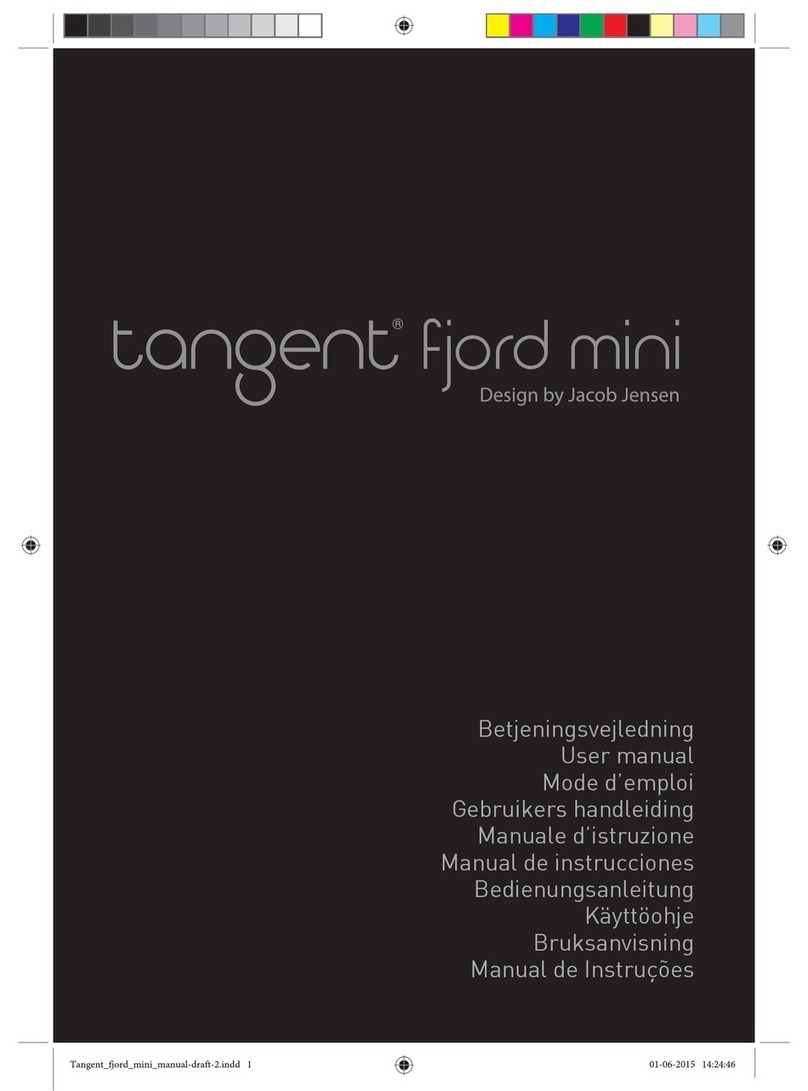
Tangent
Tangent fjord mini User manual

Tangent
Tangent CLASSIC BT User manual
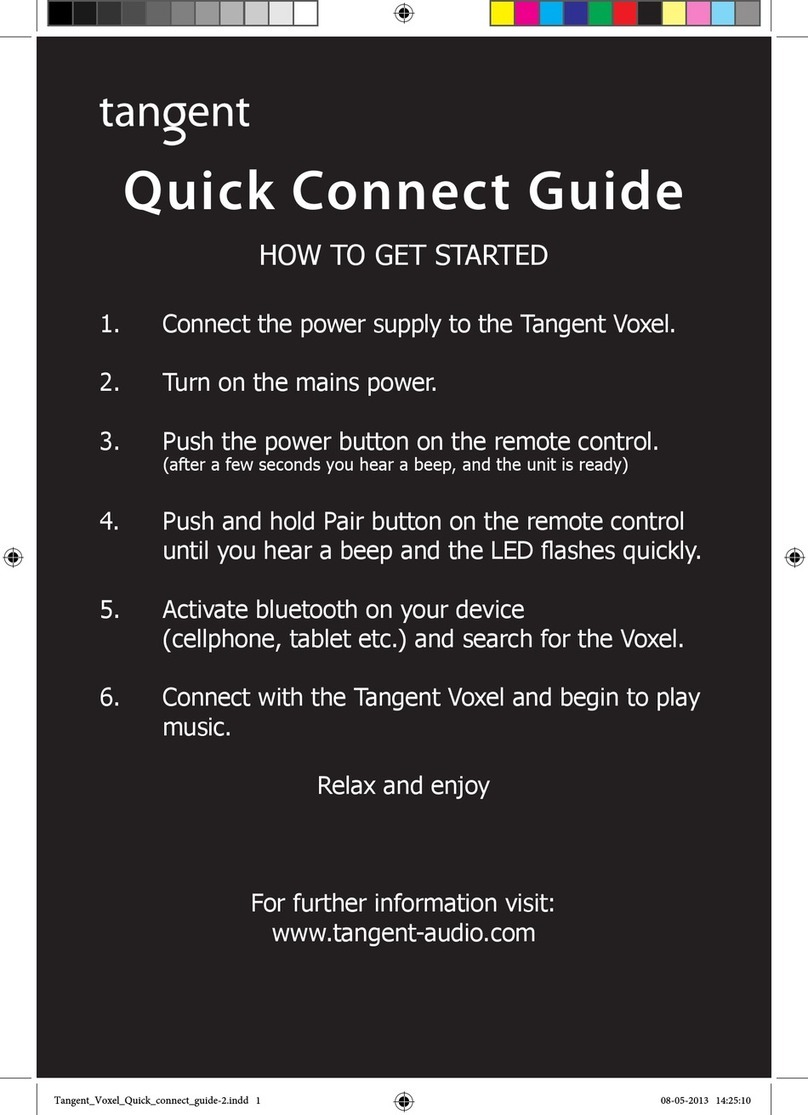
Tangent
Tangent Voxel Assembly instructions
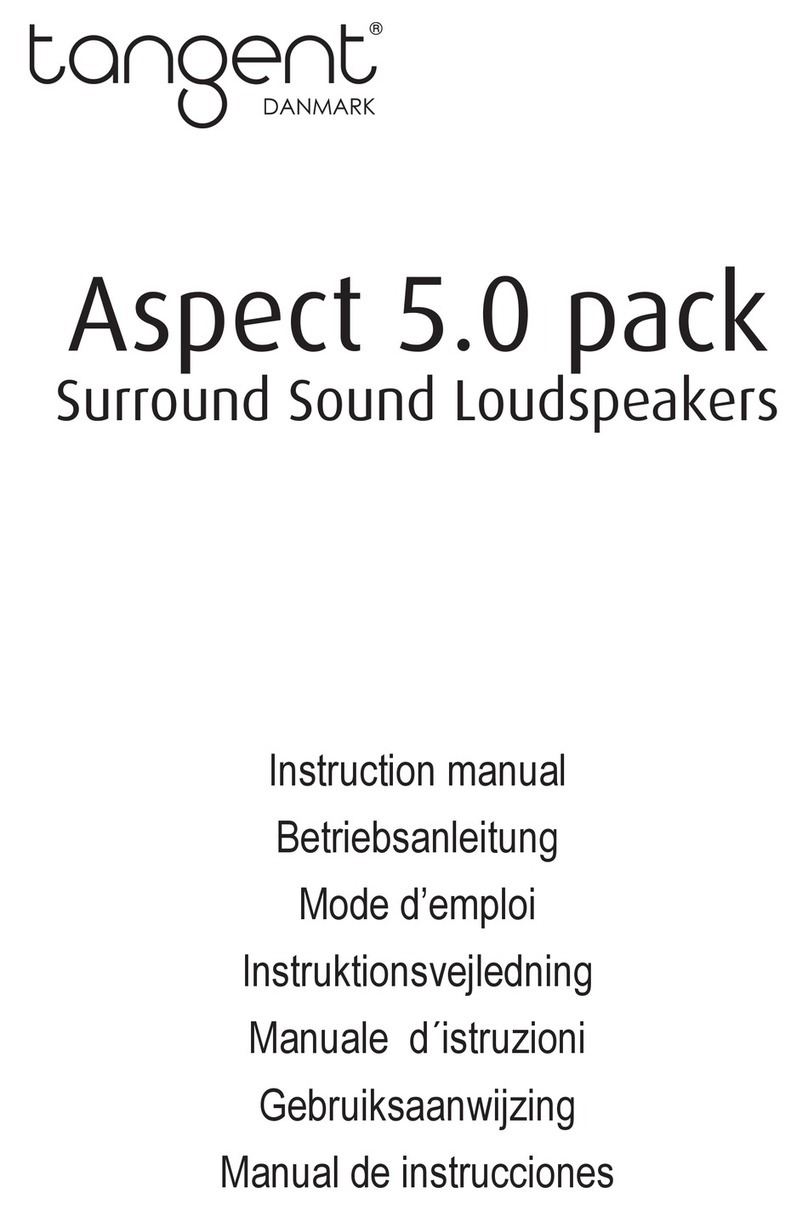
Tangent
Tangent Aspect 5.0 pack User manual

Tangent
Tangent EVO BT-30 User manual
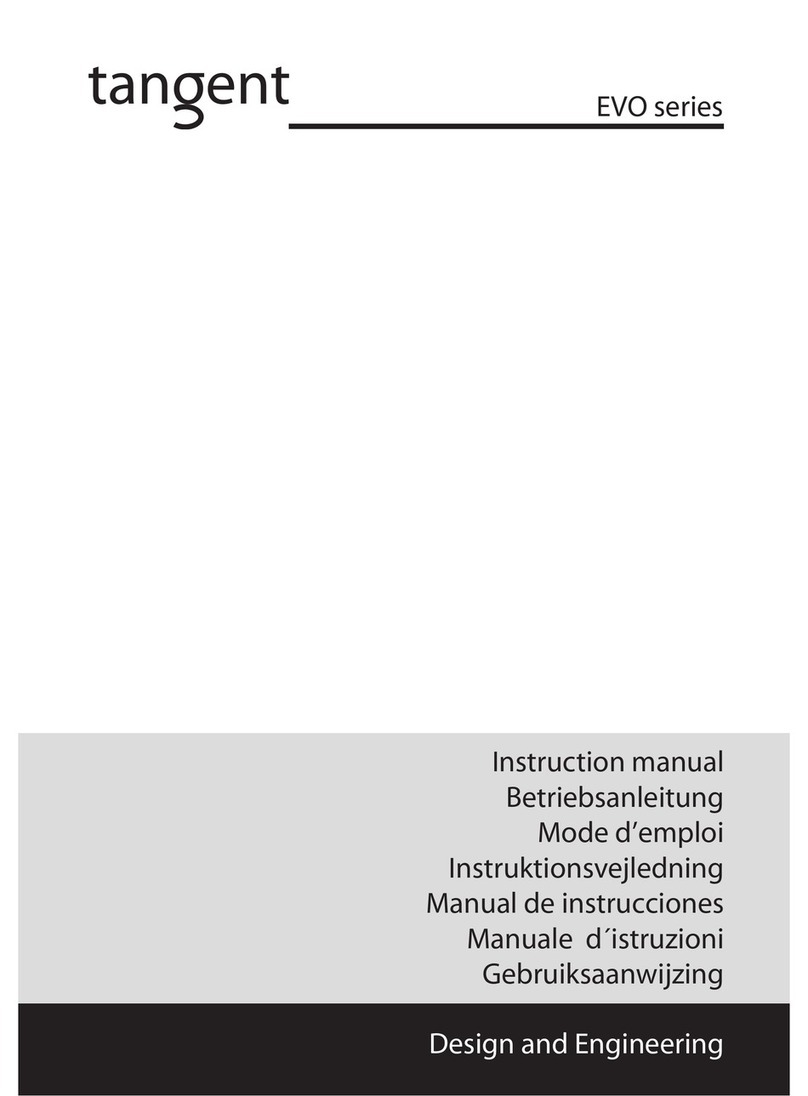
Tangent
Tangent EVO series User manual

Tangent
Tangent LS-20 User manual

Tangent
Tangent fjord mini User manual
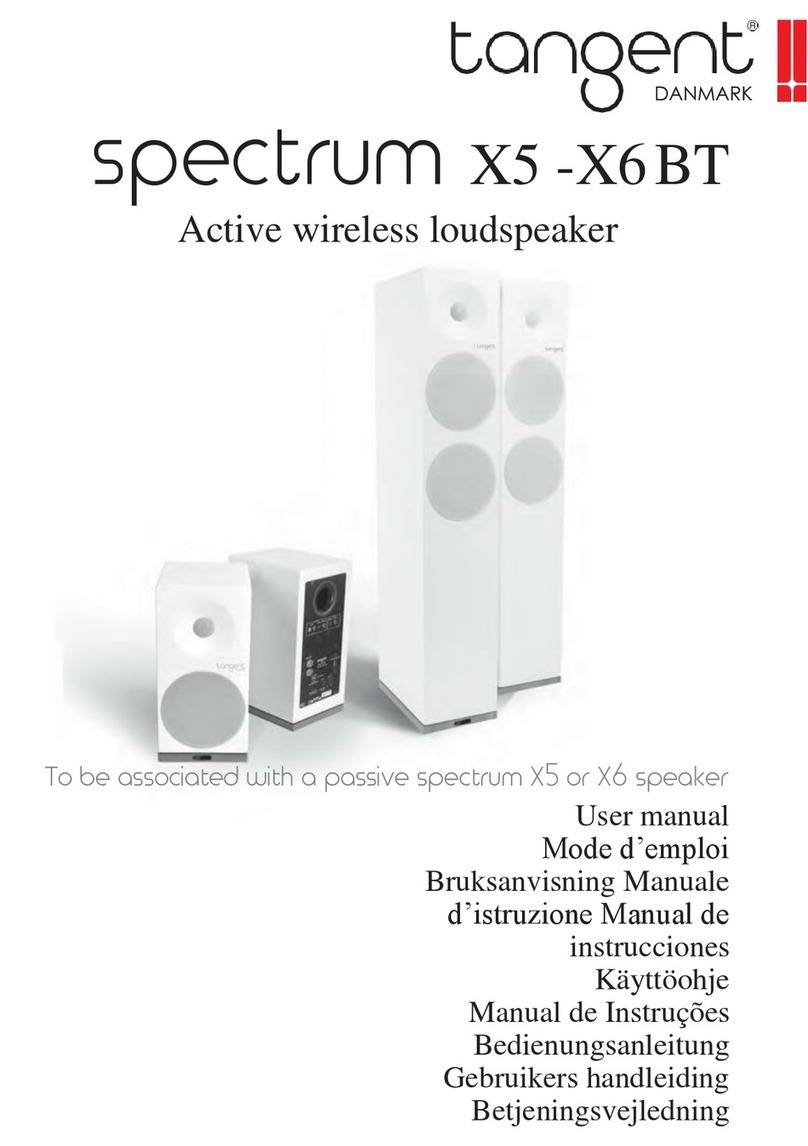
Tangent
Tangent spectrum X5 BT User manual
Popular Speakers manuals by other brands
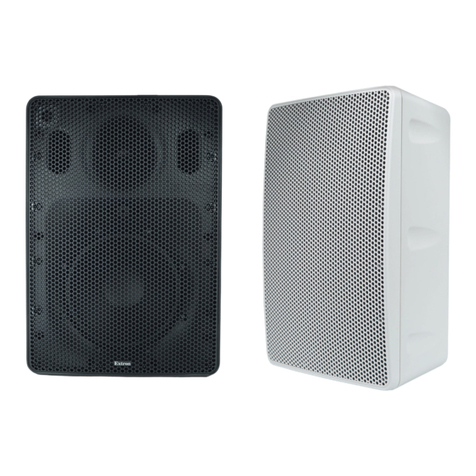
Extron electronics
Extron electronics SM 28 user guide

Furrion Lit
Furrion Lit FBS012NVP-BL Quick start guide & user manual
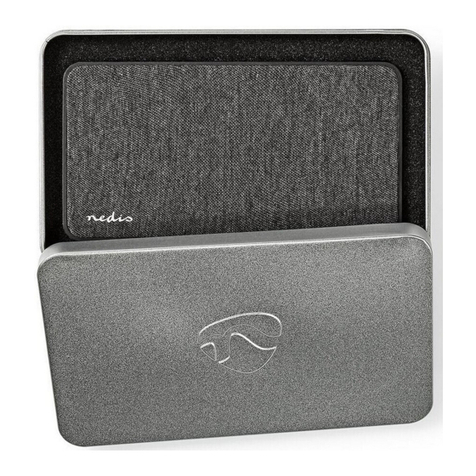
nedis
nedis FSBS110AT quick start guide
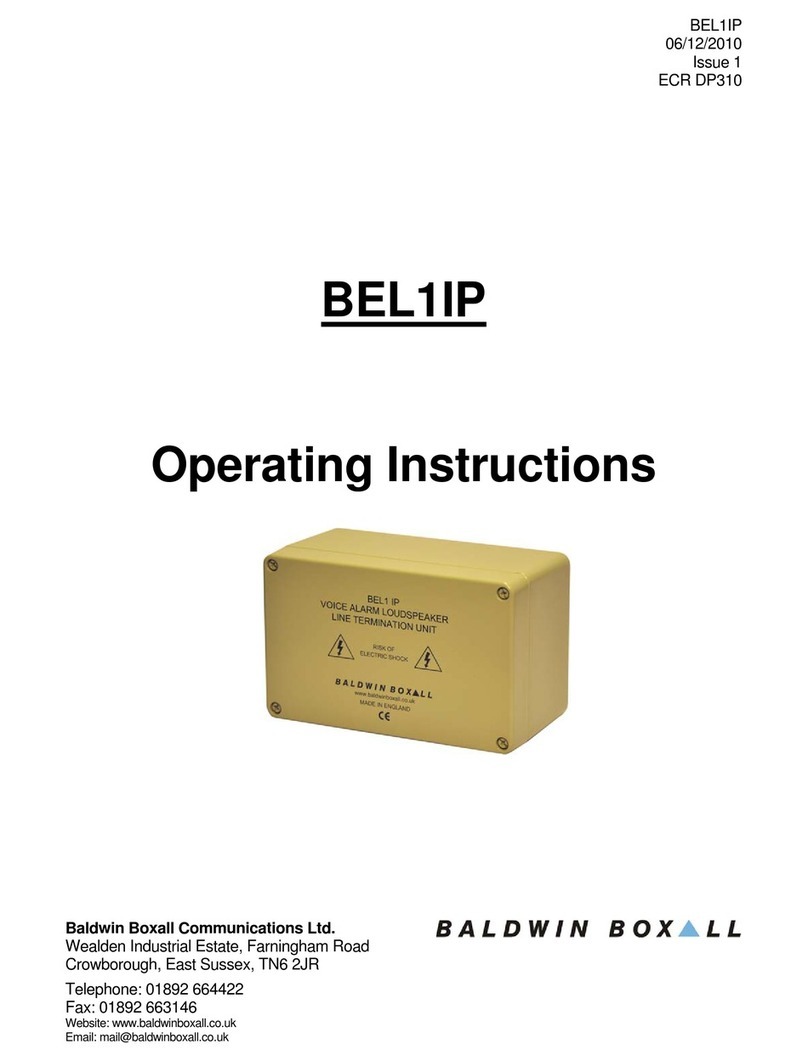
Baldwin Boxall
Baldwin Boxall BEL1IP operating instructions
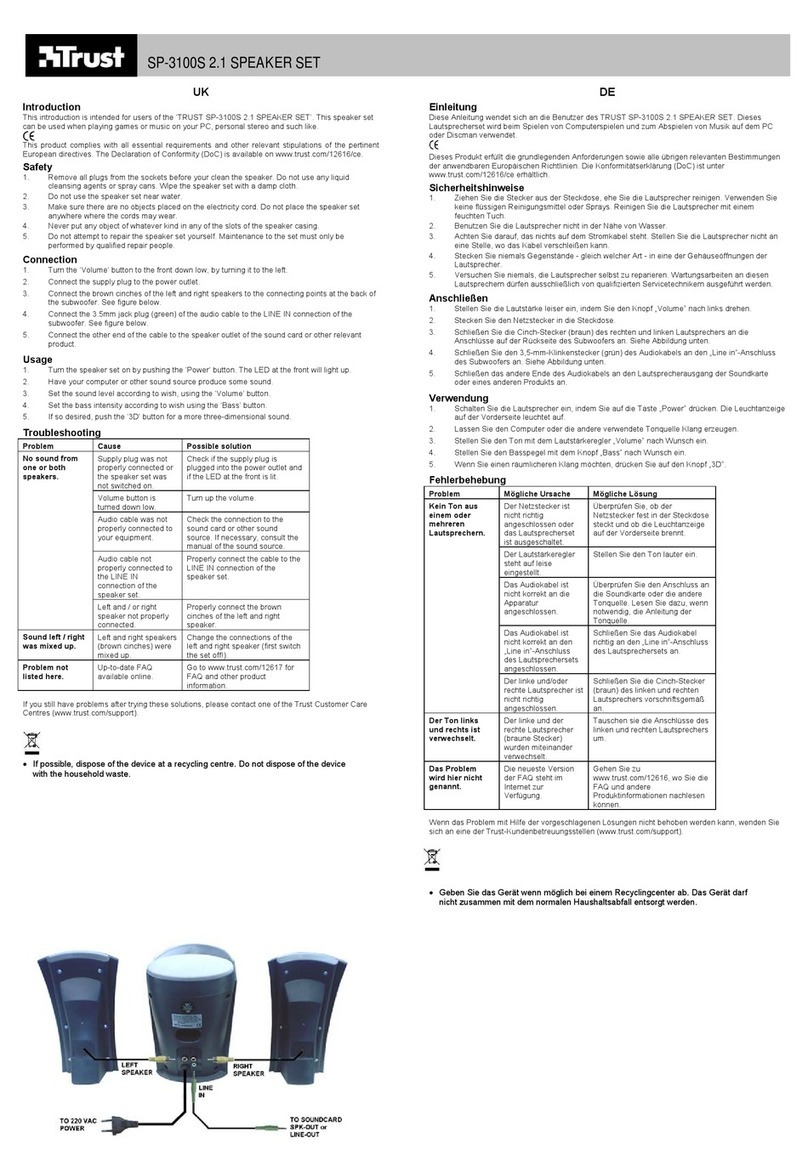
Trust
Trust SP-3100S 2.1 quick start guide

Cambridge Audio
Cambridge Audio Min 10 Specifications
